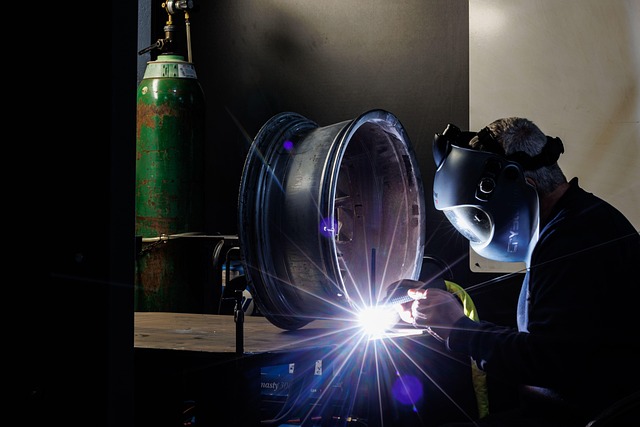Concrete cracks in stem walls may signal structural issues caused by settlement, shifting soil, or improper construction. Identifying the root cause is crucial for effective solutions, ranging from underpinning to thermal expansion filling and sealing. Regular inspection and maintenance, including proper repair techniques like epoxy injection and patchwork, ensure the longevity of concrete structures. Choosing modern materials and proactive measures can prevent crack progression and save costs in the long term, emphasizing the importance of stem wall repair for structural integrity.
Concrete cracks can weaken structures and compromise safety, especially in stem walls. This comprehensive guide explores effective concrete crack solutions, focusing on stem wall repair techniques. We dissect the causes of cracking, offering a thorough approach to identifying problems. The article contrasts short-term fixes with permanent solutions, emphasizing prevention for long-lasting repairs. Learn step-by-step stem wall repair methods and material selection tips to ensure structural integrity and enhance your concrete structures’ longevity.
Understanding Concrete Cracks and Stem Wall Damage

Concrete cracks, especially those forming along stem walls, can be both unsightly and indicative of deeper structural issues. Stem walls, which support the load-bearing capacity of a structure, are particularly prone to cracking due to factors like settlement, shifting soil, or improper construction. These cracks can range from hairline fractures to wide, open splits, and they don’t always signal a severe problem, but ignoring them could lead to more significant damage over time.
Proper understanding of these cracks is the first step towards effective concrete crack solutions, including stem wall repair. Identifying the cause is crucial; for instance, settlement cracks might require underpinning or soil stabilization, while those due to thermal expansion can be addressed through specific filling and sealing techniques. Regular inspection and maintenance are key to catching potential issues early, ensuring the longevity of your structure’s foundation.
Identifying the Cause of Cracking: A Comprehensive Approach

Identifying the root cause of concrete cracks is a crucial step in finding effective solutions. A comprehensive approach involves carefully examining the structural integrity and environmental factors contributing to the problem. Cracks can result from various issues, including settlement, erosion, poor initial construction, or ongoing environmental stress like expansion and contraction due to temperature changes or heavy loads.
For instance, stem wall repair is a common fix for cracks that originate from uneven settling or foundation shifts. By addressing these underlying causes, professionals can prevent further damage and ensure the longevity of concrete structures. This methodical process requires thorough analysis, precise diagnosis, and tailored solutions to deliver robust repairs and maintain structural integrity.
Short-Term Fixes vs. Permanent Solutions

When it comes to addressing concrete cracks, there are essentially two approaches: short-term fixes and permanent solutions. Short-term fixes, like sealing or filling small cracks with epoxy, offer quick aesthetics improvement but don’t tackle the underlying structural issues. These methods provide a temporary solution, masking the problem until it becomes more severe. On the other hand, permanent solutions focus on repairing the root cause, ensuring stability and longevity. Stem wall repair, for instance, is a permanent fix for structural cracks that extend to the foundation. It involves replacing or reinforcing the stem walls to prevent further damage.
While short-term fixes might be appealing due to their speed and affordability, permanent solutions are worth considering for critical areas like stem walls. Investing in robust repairs now can save significant time, money, and effort in the long run, ensuring your concrete structures remain intact and safe.
Stem Wall Repair Techniques: A Step-by-Step Guide

Stem Wall Repair Techniques have become a crucial aspect of concrete crack solutions, especially in older structures. The process involves careful assessment and precise application of repair methods to ensure structural integrity. Here’s a step-by-step guide to help you navigate this task.
First, identify the type and severity of cracks. Minor hairline fractures can often be addressed with surface patching compounds, while larger, deeper cracks might necessitate more extensive repairs. Next, prepare the stem wall by cleaning away loose concrete and debris using a wire brush or high-pressure washer. This ensures that any existing cracks are fully exposed and accessible for repair. After preparation, apply an appropriate epoxy injection to fill and seal the cracks, offering long-lasting reinforcement. Finally, use a specialized patch or mesh to cover larger gaps, ensuring the repaired area matches the surrounding concrete in strength and aesthetics.
Choosing the Right Materials for Longevity

Choosing the right materials for concrete crack repairs, especially in stem wall repair, is paramount to ensuring longevity and structural integrity. High-quality epoxy injections or polymeric sealers are often recommended over traditional methods like mortar patching. These modern solutions offer superior bond strength, resistance to water penetration, and flexibility that matches the expanding and contracting nature of concrete.
When addressing cracks, it’s crucial to consider both the size and type. For wider cracks, structural repair products designed for stem wall repairs can provide added support and stability. These materials are specifically formulated to withstand heavy loads and maintain their integrity over extended periods, making them ideal choices for maintaining the overall health and durability of concrete structures.
Maintaining Concrete Structures: Prevention is Key

Maintaining concrete structures involves a proactive approach, with prevention as the key strategy. Regular inspection is crucial to identify potential issues early on. Cracks, for instance, can be a sign of structural weakness or underlying problems such as improper construction, poor drainage, or environmental factors like extreme temperatures and seismic activity.
By implementing routine maintenance, including crack repair and stem wall repair where necessary, it’s possible to extend the lifespan of concrete structures significantly. Prompt action on minor cracks prevents them from expanding, which could lead to more severe damage and costly repairs down the line.
